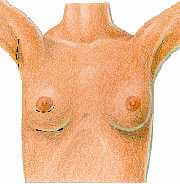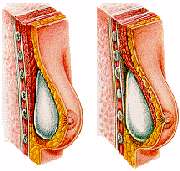View Before/After Photos


























































































Read our Frequently Asked Questions about Breast Augmentation
Throughout the ages, physical beauty has been determined by the values of each society. In our western culture during the late 1890′s, for example, the large breasted woman with the small waist was the ideal. In the “flapper” era of the 1920′s, women wanted slim bodies and very small breasts. Because an individual’s body build is determined for the most part by genetic influences, women may not be able to achieve the look they want through diet and exercise alone. Today, through modern technology, many women are able to alter the shapes of their bodies. Some with small, underdeveloped, or asymmetrical breasts may choose to undergo breast augmentation, a safe, effective surgical procedure designed to improve the contour of a woman’s body by implanting specially designed materials beneath the breast or chest wall muscles.
Before Surgery
Prior to surgery, a complete medical history is taken in order to evaluate the general health of the patient. A thorough examination of the breasts is also made to determine the most effective surgical approach. The physician describes the type of anesthesia to be used, the procedure, what results might realistically be expected, and the possible risks and complications.
Mammograms will be taken as well as photographs. Preoperative instructions often include the elimination of certain drugs which contain aspirin in order to minimize the possibility of excess bleeding. Birth control and other estrogen containing hormones may also be discontinued temporarily for the same reason. Antibiotics designed to prevent infection will be prescribed.
The Procedure
A breast augmentation is usually performed in our state-of-the-art outpatient surgical setting under general anesthesia with the patient asleep. A local anesthesia in which the patient remains awake and the area is numbed may also be used. The physician may choose from a variety of surgical procedures, depending upon what changes are desired. Prior to surgery, pre-medication to relax the patient is administered and breasts are carefully marked to indicate where incisions are to be made.
One of the techniques most frequently used is an incision made in the lower portion of the breast near the chest wall or around the lower portion of the areola (the dark pink area circling the nipple). Another preferred location used is in the armpit. (Fig. A) When the incision is made in the lower portion of the breast, breast tissue is raised to create a pocket either under the breast tissue (Fig. B) or beneath the chest wall muscle. (Fig. C) An implant containing a silicone gel and a saline solution is inserted into the pocket. In some cases, particularly those in which there is breast asymmetry, an inflatable implant may be used. With this procedure, the surgeon can adjust the amount of inflation.
FIG. A FIG.B
After the implant is securely in place, small sutures are used to close the incision. A breast augmentation can take two hours or more, depending upon the procedure and extent of the surgery.
Following Surgery
Following surgery, the patient wears either bandages or a special garment. These are usually replaced in a few days with a surgical bra which is worn for several weeks. Patients who are operated on are released the day of surgery.
Pain connected with the procedure is minimal to moderate and is controlled with oral medication. Antibiotics may be prescribed to prevent infection. Instructions for the day of surgery include bed rest and limited activities. The physician determines when normal activities can be resumed; however, strenuous exercises and overhead lifting must be avoided for several weeks.
Sutures are removed in about five to seven days at which time the physician may recommend massage to keep the breast supple. Numbness around the treated area may occur, but this condition is usually temporary. Swelling and discoloration disappear in a few days to weeks, and scars from the incisions, although permanent, fade significantly with time.
Complications of infection and slow healing are rare; however there are certain inherent risks connected with every surgical procedure which should be thoroughly discussed with the physician. Patients can minimize complications by carefully following directions given by the physician. In some cases in which the breast becomes too firm due to the formation of scar tissue, a second procedure may be necessary.
Copyright © 1997 Contemporary Health Communications, Chesterfield, Missouri (Commercial use strictly prohibited)





